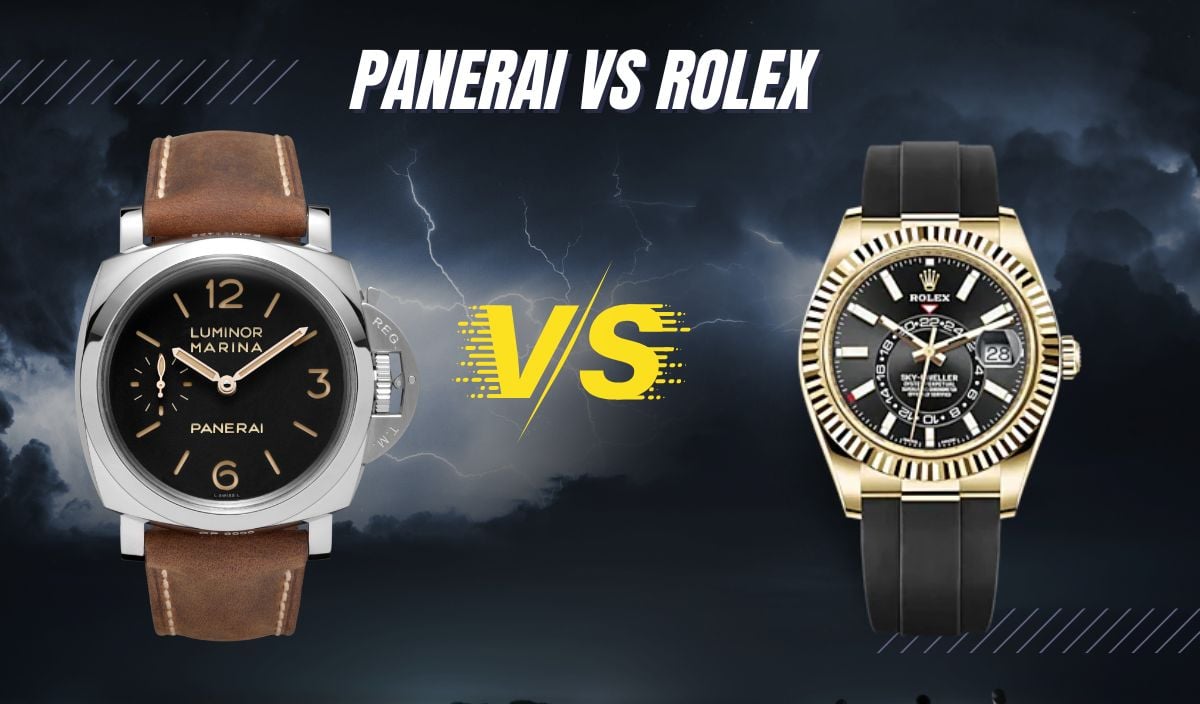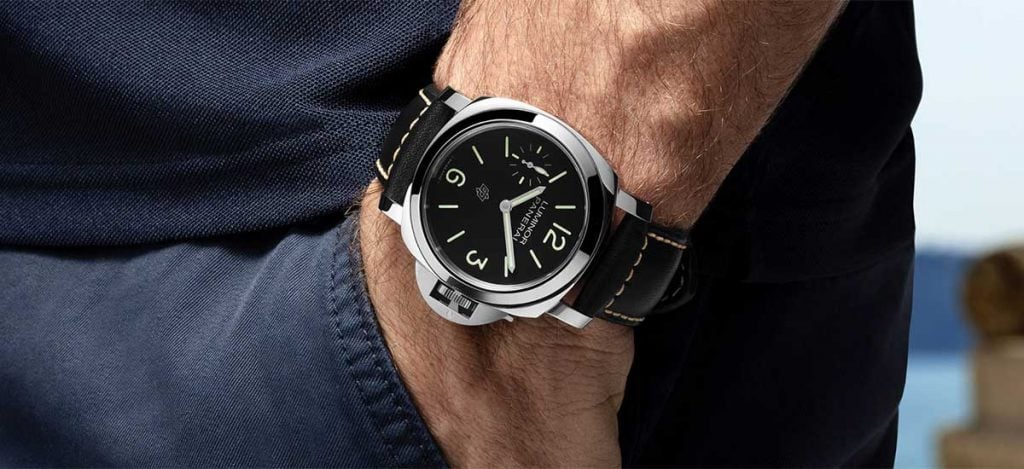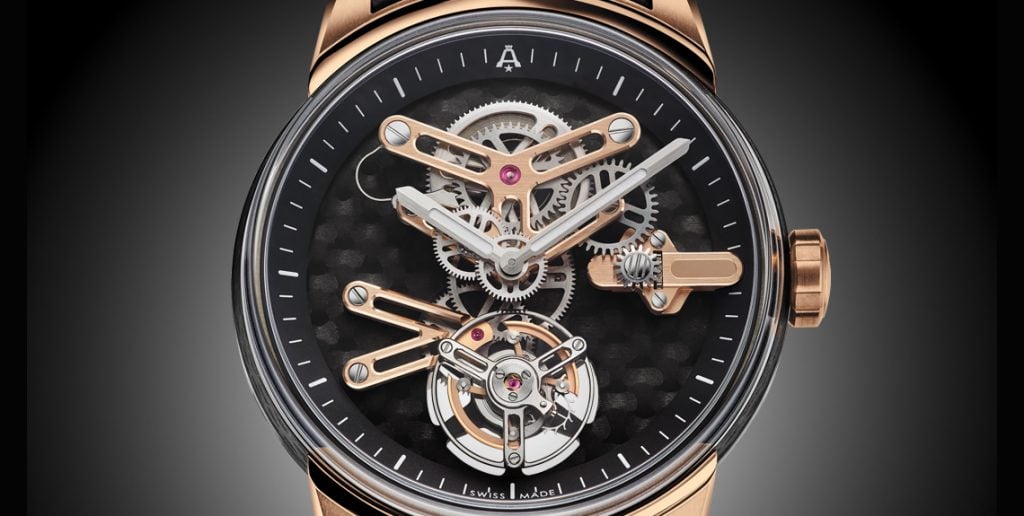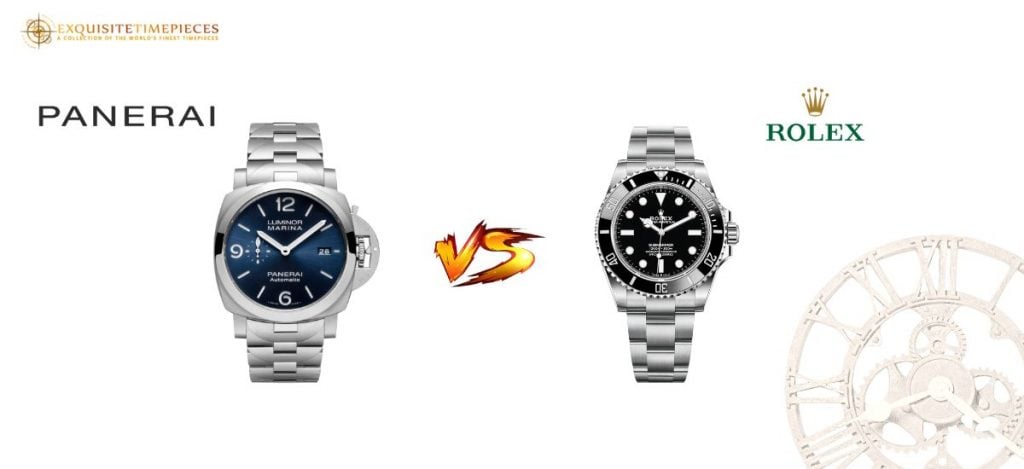
Panerai Vs. Rolex Watches (EVERYTHING You Should Know)
If you’re still confused between Panerai and Rolex, then you’ve come to the right place! We’ll take a deep dive into the differences, similarities, and pros & cons of both the brands. Let’s begin with their origins and see how they came to be what they are today!
Panerai History- Early Years
Panerai was founded in 1860 by Giovanni Panerai in Florence, Italy. From its inception, the shop was both a retail establishment and one of the first watchmaking schools in Italy. By 1916, Panerai was producing high-precision instruments at the request of the Italian Royal Navy. As a requirement, the Navy wanted dials that could easily be read in the dark and underwater.
Hence, the patented process of a highly luminous compound (originally a radium paste) was created and patented and the original “Radomir” was produced. This luminescence became a key element of the Panerai collection.
In 1936, the Radiomir prototype was developed for the Italian Royal Navy. These pieces needed to meet the parameters of a high-strength diving timepiece. This was accomplished by modifying a watch case supplied by Rolex which was referred to as the 2533 prototype.
By the 1940s the “Radiomir” had evolved into the instrument that most are familiar with today (ref. 3646). The characteristics of this watch consist of the following:
- A large cushion-shaped steel case with a 47mm diameter
- Highly luminous dial and markers
- Wire lugs that are welded to the watch case
- High-quality manual mechanical movement (at that time a Cortebert/Rolex 618 caliber.)
- A tan, water-resistant strap long enough to be worn over any protective clothing.
An additional advancement was the addition of a modified dial using overlapping discs, known as sandwich dials. The upper part consisted of anodized aluminum with perforated indexes and numbers to make the radium paste more luminescent and legible.
The Luminor

In 1949, the “Luminor” name was issued a separate patent due to the luminescent properties of the dial. Instead of a radium paste (which carried various risks due to emissions), Panerai developed a tritium-based substance, a hydrogen isotope, that was safer and did not sacrifice luminosity. Because of these developments, the patent was acquired and became synonymous with the dial qualities.
Another significant engineering feat was achieved in 1956, when Panerai, in developing a diving watch for the Egyptian Navy, introduced the patented crown-protecting device which is structurally most identifiable within the Panerai collection today.
Throughout the 1960s the “Luminor” continued to evolve and was improved upon. The crown protection bridge was adapted to the watch case and advancements were also made in its movement. The Swiss-made Angelus SF240 mechanical movement featured an 8-day power reserve. This power reserve feature would become part of the very DNA of the brand.
Another major innovation is that some of the solid and closed-back watches were replaced with a plexiglass window allowing one to view the movement. At this time, Panerai was one of the first watch houses to outfit a watch accordingly. Today, this is a common feature on high-end brands bearing either mechanical or automatic watch movements.
Panerai Tourbillon in the 21st Century

As Panerai entered the 21st century, the first of many in-house created movements were introduced. In 2005 the P2002, a hand-wound mechanical with GMT function and an 8-day power reserve was unveiled. Then, in 2007, the P2003, P2004, and P2005 were introduced. What distinguishes the P2005 is its most elegant tourbillon complication.
A tourbillon is an addition to the mechanics of a watch escapement to increase accuracy. In a tourbillon, the escapement and balance wheel are mounted in a rotating cage aiming to eliminate errors of poise in the balance giving a uniform weight. It was initially developed by the watchmaker Abraham Louis Brequet in 1795.
The unique characteristic of the Panerai tourbillon is that the cage housing the balance wheel and the escapement rotate on an axis that is not parallel to the balance wheel axis but perpendicular to it. Unlike traditional tourbillons in which the cage completes one rotation per minute, the cage in the Panerai completes one rotation in thirty seconds. Very innovative.
Panerai continued to develop and create more in-house movements and incorporated more and more complicated features into their collection. In 2010, a commemorative watch and clock were introduced to celebrate the 400th anniversary of Galileo’s first celestial observations. Incorporating a variety of complications, these models continued to build on the creative and innovative reputation of the brand.
2013 saw the launch of the P9100 caliber, an automatic movement with a chronograph flyback function, the P9100/R with a regatta countdown feature, and the P5000 caliber hand-wound movement with an eight-hour power reserve. A pocket watch with both GMT and a tourbillon with a ceramic case was also introduced to the watch world.
2014 saw Panerai open a brand new watchmaking facility in Neuchatel, Switzerland. The innovation continued with the P4000 caliber, an automatic movement distinguished by an off-centered oscillating weight.
Panerai Radiomir and Luminor Due
Over the past eight years, Panerai launched the Radiomir 1940-minute repeater carillon tourbillon and the new Luminor Due case. The Radiomir is the most complicated watch Panerai has ever produced. It incorporates the exclusive tourbillon regulator and the unique double repeater mechanism that chimes either local time or a second-time zone with the ability to sound every hour, every ten minutes, and every single minute using 3 hammers striking three different sounds.
A low sound for hours, an intermediate one for 10-minute periods, and a higher tone for minutes. The Luminor Due reflects the thinnest automatic movements ever created by Panerai and is faithfully inspired by the classic 1950s model.
Panerai Latest Innovations
Strides in using various materials such as carbon and the development of BMG-TECH which is a bulk metallic glass with a disordered atomic structure obtained through a high-pressure injection process at a high temperature further advanced the Panerai collection.
2018 was marked by the unveiling of two remarkable innovations, the first being the Lo Scienziato-Luminor tourbillon GMT with a 3D printed titanium case coupled with the P2005/T skeletonized movement with a tourbillon regulator. The second complication was the L’Astronomo-Luminor 1950 tourbillon moon phases equation of time GMT.
This is the first Panerai creation to have a moon phase indication and an innovative system using a polarized crystal to indicate the day. To celebrate the 70th anniversary of the patented Luminor name, the company created a brilliant innovative model with a greater luminosity that is guaranteed for seventy-plus years.
Rolex’s History
Rolex, surprisingly, has been around for a far shorter time than Jaeger LeCoultre and compared to most other luxury Swiss brands. For a brand that has been around for less than 115 years, is an even greater testimony to the success of the Rolex brand and the reputation the company enjoys today.
Much of this success is attributable to Hans Wilsdorf, the English entrepreneur responsible for the creation of the brand. Though conceived in England, Wildorf created the Rolex brand in 1908 and would ultimately move the entire operation to Geneva, Switzerland, where he would create the first water-proof self-winding wristwatch with a perpetual rotor.
A patent was issued to Rolex in 1926 for the world’s first waterproof watch, which today is the oyster case. Rolex has filed for more than 500 patents over the history of its existence. These patents showcase their innovations that range from internal movements to their exclusive Cerachrom bezels and bezel inserts.
Cerachrom is a ceramic material that is virtually impervious to scratches and its color is unaffected by the sun’s ultraviolet rays. Rolex today is a completely vertically integrated company with every step of the watch’s conception to completion performed by the Rolex team.
To assure the continued success and commitment to producing the highest quality timepieces, Rolex has an exclusive training center that educates, trains, and acclimates every employee to their culture of excellence as well as one of the most rigorous testing labs to ensure the integrity of every watch.
There is even a department of tribology where the scientific study of friction, wear, lubrication, and how moving parts interact in every aspect of a watch’s movement and physical parts exists to continue Rolex’s constant perfection in watchmaking.
Another attribute of the Rolex collection is its commitment to precision and accuracy. In this aspect, every Rolex is not only a certified chronometer but a superlative chronometer as reflected by the certificate and green seal that accompanies each wristwatch. The parameters of accuracy exceed those required by the COSC. which are -4/+6 seconds per day. The superlative identification reflects a deviation of -2/+2 seconds daily.
Panerai Luminor Marina vs. Rolex Submariner

The Luminor Marina is available in different sizes and ranges from $8100-$13,900 with a top-of-the-line model offered at approx. $24,300 (available in a Goldtech case which is made of gold, 24% copper, and titanium).
The basic 44mm case models range from the strap version for $8100.00 or the all-steel version for approx. $8900.00. These models have a Panerai caliber P9001 31 jewel automatic movement. A Glucydor balance and the incabloc anti-shock mechanism as well as two barrels and a total of 200 components and a power reserve of three days complete the movement.
There is also a carbotech model available which has a carbon ceramic case and bezel and brushed titanium back. These models are water-resistant to 300 meters. These 44mm models are available in either blue, olive green, or dark gray with complimenting straps.
There is also a limited edition Luminor Marina which has a 47mm case and retails for approximately$10,100.00. This model has a Panerai P3001 caliber movement and is available with a dark brown dial and a brown strap.
Lastly, within the Marina collection, there are the ESteel models. They retail for approximately $8700. And have polished steel bezels. What differentiates these watches is that the cases are constructed of recycled materials comprising 58.4% of the weight of the case.
The Submariner is one of the Rolex collection’s most popular watches. For comparison, I will elaborate on the features of the base model which is available in stainless steel in either a date or non-date version. The dimensions of the case are 41mm. Wide and 48 mm. From lug to lug. The lug width is 20 mm. And the case is 12.5 mm. Thick.
The heartbeat of this watch is an automatic mechanical caliber 3130 in-house manufactured Rolex movement. The watch has a power reserve of two days. The timepiece is outfitted with a sapphire crystal and a cerachrom bezel with markings filled with platinum PVD coating.
To round out its appearance the dial has “Blue” chromalight lume markers for easy visibility in the dark or underwater. Water resistance is rated at 300 meters. The approximate retail for the non-date model is $8950.00 and the date model is $10,100.00.
Panerai Submersible vs. Rolex Submariner
In comparing these two watches against one another, I refer you to the previous paragraph for technical details of the Rolex Submariner.
The Panerai Submersible has a 42mm. 316L brushed stainless steel case and is also water resistant to 300 meters. The mechanical automatic movement is an in-house Panerai P9010 caliber that vibrates at 28,800 A/h. It features an incabloc anti shock device, glucydur balance, 2 barrels, a total of 200 components, and a power reserve capacity of 3 days.
One distinguishing feature of both the Submersible and the Luminor Marina is the ease with which the wearer can change straps and bracelets. This process is easier with the Panerai models than with most other Swiss luxury brands. The approximate retail price of the Submersible is $9300.00 retail.
Frequently Asked Questions
Given the comparison of both timepieces and their attributes, both are superior-quality dive watches. The Rolex is the more recognizable of the two, but Panerai has a devout following of watch enthusiasts and professionals that swear by the brand, and production often falls short of demand for their watches. Either is a brilliant choice for a high-end Swiss luxury watch / professional instrument.
As in the comparison of the Panerai Submersible and the Rolex Submariner, the same side-by-side analysis pertains to the Luminor Marine and the Submariner. Both have similar attributes and are water-resistant to the same depth. Both have luminous treatments for easy visibility in the dark and underwater.
The greatest departure is in the overall appearance of the timepieces. The Panerai case is highly unique whereas the Submariner possesses the distinct oyster case that has made Rolex famous. Both are on equal footing in aspects of quality and materials. The ultimate decision of which to purchase lies with the wearer and which watch they prefer to wear on their wrist.
The suggested retail prices for each model are as follows;
-Panerai Submersible: $9300.00
-Panerai Luminor Marina: $8900.00
-Rolex Submariner (Date): $10,100.00
Rolex does not own Panerai. Since 1997, Panerai has been part of the Richemont Group. This is a luxury goods conglomerate that owns other fine Swiss luxury brands such as Cartier and IWC.
Rolex and Panerai did work in partnership together in the 1930s. Their collaboration was built around Panerai’s luminous technology and Rolex’s patented waterproofing technology. The ultimate result was a dive watch produced for military use named the Radiomir. The watch had superior legibility underwater and in the dark.
Rolex offers a five-year warranty. Panerai’s warranty is for two years but can be extended to eight years if the purchaser registers the watch with the company online during the initial warranty period.
I believe that both are excellent values for the price paid. Each employs superior materials and is a meticulously crafted timepiece. One can spend far less to get a quality diver watch, but both of these brands are in a distinct class due to their history and exclusivity.
Rolex watches hold their value better than most other Swiss luxury watch brands. Due to their popularity and demand, the Rolex brand has a secondary market that is the envy of most brands. Panerai watches are also in high demand but are produced in far lesser quantities than Rolex. They do experience depreciation after purchase but do enjoy demand as used timepieces.
Some of the individuals wearing Panerai watches are Mike Horn, the world’s greatest modern-day explorer, Gregorio Paltrinier, a world champion Olympic swimmer, and Sylvester Stallone who chose to wear a Panerai in the 1996 film Daylight. Panerai timepieces are treasured for their accuracy and ruggedness among these types of elites.
In conclusion, both the Panerai and Rolex brands are excellent choices. They each reflect distinctly different designs but are each diver worthy and reflections of the taste and discerning choice of the wearer. The Panerai may be more of a conversation piece and enjoy a more colorful history, but the Rolex is also a great-looking alternative and speaks for itself due to its recognizability as a swiss luxury watch
About Exquisite Timepieces
Established in 1998, Exquisite Timepieces is your one-stop shop for all things luxury watches! We are an authorized dealer for 60+ luxury watch brands including Omega, Hublot, Seiko, & Longines! We are proud to showcase one of the world’s largest pre-owned watch collections, including renowned brands like Rolex and Patek Philippe. Check out our brand new watch arrivals here and popular pre-owned listings here.











